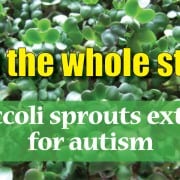Dr. Sidney Baker: A Biomedical Approach to Autism

Interview by Sheila Rogers DeMare: Countless people have benefited from the understanding that autism is a medical condition that can be treated. But in 1996, when this interview took place, this was a new concept, met with considerable opposition. Dr. Sidney Baker was a key player in developing a method to address previously unrecognized medical issues in autism. He was coauthor of the first protocol for clinical assessment options for autism and related disorders—a protocol that represented a consensus of over twenty participants from diverse medical and scientific backgrounds and has been refined over the years. The protocol was developed after the first Defeat Autism Now! Conference, a conference that now draws large crowds and international participants. The interview provides parents with an understanding of the concept of this approach, which has helped so many families.
Dr. Baker, when you refer to autism and “related disorders,” what are those disorders?
Attention disorders, specifically. At the 1995 DAN! conference organized by Dr. Bernie Rimland, Dr. Jon Pangborn, and myself under the aegis of the Autism Research Institute, the consensus of physicians and scientists was very strong that there is a landscape of disorders in which autism represents one mountain peak. If you’ll accept the metaphor, nearby is the more typical child with attention deficit hyperactivity disorder, but a very high shoulder connects these peaks. In other words, these are not different problems so much as different expressions of common underlying difficulties.
These underlying difficulties represent a well-defined genetic problem that has to do with the genes that code for immune function that are found on chromosome number six. This finding is primarily the work of Reed Warren, PhD, and his associates at Utah State University. I think it is clear that, in a certain sense, autism is a severe expression of difficulty paying attention, so to speak. Someone hearing those words would have to understand the background from which they are spoken. There is a way of trivializing this concept, but I don’t mean it in a trivial sense. There is a deep connection.
What about Tourette syndrome — do you see a connection with it?
I’ve seen many children who have been given the Tourette label whose problems were relatively easy to correct through environmental medicine approaches. Another group with that label might not respond to that approach. In terms of the landscape metaphor, I would say, yes, there is a connection, but it is narrower than the one I talked about.
You mention environmental medicine. I know you are a graduate and former full-time faculty member of the Yale Medical School and prior director of the Gesell Institute for Human Development. How did your interest in environmental medicine and autism evolve?
Environmental medicine interest developed in the early 1970s, after I left the faculty at Yale. While at Yale I gained fifty pounds, couldn’t see my feet anymore, and didn’t realize they were pointed in the wrong direction. I decided to find something I was not only good at, but that I enjoyed. Although I was in a section of medical computer sciences, which still occupies a good deal of my interest, I felt I could apply my skills better if I were a “real” doctor rather than an academic. So for seven years I worked as a family practitioner, using my training in obstetrics, gynecology, and pediatrics.
Right away, listening to people’s stories, I found that their health experiences had certain features that didn’t correspond with the medical education I had received. When giving their histories, they would say things, for example, like they couldn’t eat anything with eggs. I’d ask what would happen if they ate eggs — or any other food they mentioned — and their responses opened my mind to the possibility of food allergy reactions. The patients seemed very credible. I had been taught that food allergy was obvious — someone might break out in hives after eating shrimp. But the concept of delayed, subtle, and mysterious food sensitivities was never covered in my training. So I felt ill-equipped to help people in this area; I didn’t know how to go about the necessary detective work.
Then I had patients who right under my nose would go out and consult a health practitioner of whom I may have held a dim view, given my arrogant Yale background, and they would come back and tell me how they felt marvelous after starting particular supplements for their headaches, PMS, joint pain, or whatever. And I would respond, “Oh, r-e-a-l-l-y.” Because I had been taught to sneer at anything that had to do with nutritional supplements. These two kinds of reports began to leave me feeling quite insecure that somehow there was something big going on out there that I didn’t have a background in. That’s what triggered my interest in nutrition and environmental medicine.
And your interest in autism?
Before becoming director of the Gesell Institute, I was the medical consultant to the regional center in New Haven where children or adults with severe developmental abnormalities lived in a residential center. One cannot meet an autistic person without realizing that something very deep and mysterious is taking place, and if one could understand it, one might understand important things about our human condition. My interest was kindled by looking into the eyes of people with autism, but I felt completely at sea in terms of trying to figure it out medically. At least my Yale education had given me a touch of grandiosity, so I wasn’t completely intimidated by the challenge.
I had been trained to take a person’s history, do some laboratory tests, examine the patient, and give them a label. Then I would treat the label. As I became more interested in individual differences, I began to take on people who either couldn’t find a label or who had been told that nothing could be done about it. I also became more comfortable with the idea that healing might have more to do with nutritional biochemistry and environmental approaches than with prescribing toxic drugs.
How did you connect with Dr. Rimland and the Autism Research Institute?
I had begun to develop an interest in so-called yeast problems during a friendship with Dr. Orion Truss. Then I noticed in Dr. Rimland’s newsletter that children with autism were reported by parents to have a very high incidence of positive response to antifungal drugs such as nystatin. Of course, having large numbers of parents report this seemed much more credible than something one might read in a journal! So I associated more with Dr. Rimland. I also began to see more autistic children myself, and found that many did respond to antifungal drugs — though at the time I felt rather shy about this, since it seemed so controversial.
Are most of the lab tests recommended in the protocol covered by insurance?
My response to that is: ha, ha, ha. Actually, given the tenor of the commercialization of health care and the tendency of the insurance people to want to save a dime on anything, it amazes me that they do often pay for everything, but there are many variables.
What suggestions do you have for parents of young children with autism or related disorders who cannot afford to pursue this type of approach?
Let me offer recommendations included in the protocol:
- a varied diet of fresh, unrefined foods
- a trial of vitamin B6 and magnesium supplements
- a trial of multiple nutrients, with an emphasis on vitamin B6, magnesium, calcium, zinc, and selenium
- a trial of dimethylglycine
- a gluten-free and casein-free diet
- a yeast/mold-free diet
- a diagnostic trial of avoidance of all commonly allergenic foods
- anti-fungal medications such as nystatin or fluconazole (Diflucan)
- peptidase-rich digestive enzymes such as those prepared from papaya and pineapple.
What expectations should parents of autistic children have?
It is important to mention that the protocol describes a consensus as to the key diagnostic tests that might be useful. It intentionally avoids making a prescription for treatment, mainly because treatment is so individual that it should not appear that one size fits all. Also, there is probably a wider divergence of opinion, a more difficult consensus to achieve, in deciding on treatments.
Is age a factor?
Age is a major factor. We are trying to figure out now what defines the group that really seems lost, so to speak, and does not respond.
Is it difficult to get parental compliance?
Well, one therapeutic approach is associated with very dramatic response in some children, and that is the gluten and casein-free diet — the peptides issue. Gluten is in wheat and other grains, and casein is in milk. That diet is not something that can be entered into halfheartedly. Mother Nature seems quite unforgiving in that, and a little bit of peptide goes a long way.
Could you help us understand about peptides and the rationale for these diets?
The key point, which is awfully important but is a little hard to explain, is that the toxicity of molecules that are close mimics of our own biochemical gear is really a very special kind of toxicity. When your body finds within it a molecule that it recognizes as unwanted, strange, and foreign, it has mechanisms for getting rid of it that are relatively efficient, though there are some exceptions to that — like aluminum is very hard to get rid of, even though it is definitely strange.
But these are molecules that look very much like your own molecules, so that at first glance your body doesn’t notice that it’s a bad thing. It gets mixed in with your chemistry and can cause mischief that is much more complicated and dangerous than something from a stranger type of molecule. This principle applies to peptides that come from gluten and casein — which can enter the bloodstream if the digestive process breaks down or there is a leakiness in the intestinal wall — and that look like our endorphins. It also applies to the toxins that come from yeast that look like the intermediaries in the so-called Krebs cycle, the components of our energy metabolism.
Both these kinds of molecules — fungal toxins and peptides from food — are toxic, because they look so much like our own stuff and get mixed into our own chemistry and can influence it strongly without being recognized and dealt with as toxins. I’ve written a book recently called Detoxification and Healing, and I try to explain this point in that book. Many autistic children have a genetic predisposition to negative peptide reactions.
In the protocol, certain labs are recommended for specific tests. On what basis were those labs selected?
Let me first say that the protocol was intended to begin from a certain platform. Sometimes professionals, when working with a child with a particular diagnostic label, will explain away anything that happens with “Oh, well, that’s because he’s autistic.” There is a tendency to be blinded by the obvious. Therefore, things like iron deficiency, or lead poisoning, or not enough calcium in the diet and things like that are overlooked. Such issues can be quite important. So one should not overlook normal types of tests, such as blood counts, urinalysis, a blood chemistry screen including thyroid tests, an amino acid and organic acid screen, chromosome studies for fragile X syndrome, MRI, CAT scan, EEG or x-rays when indicated, or a Landau-Kleffner screening if needed. It is assumed that these tests would have been addressed before one gets rolling with the protocol.
Regarding the rationale for sending specimens to the specific labs we recommend — first, they may be the only lab doing the tests in question, such as Dr. Reichelt’s lab in Norway for urinary peptide studies, and Great Smokies Diagnostic Laboratories for the stool test and permeability studies. Some of the tests are quite special and you simply cannot get them from your local hospital, etc. Second, the lab may have taken a special interest in providing a particular profile at a reduced rate.
There could be a third reason, which is that the lab has agreed to participate in a project, with parental permission, by providing lab data for our database. This is important, because from a research standpoint, to get results from two different laboratories on the same test is an absolute nightmare.
What method do you suggest for determining food sensitivities in children? I know kids with autism can have very unusual eating patterns.
I think the IgG ELISA test from Immuno Laboratories in Ft. Lauderdale is indispensable for autistic children who really can’t be tested with skin techniques and for whom provocative testing is too unruly a situation. If you’re taking blood, you may as well get enough for the IgG test. The test has controversial standing among some allergists, but I’ve conducted two double-blind placebo-controlled studies showing that, at least from this laboratory, it works very well. It is a test that requires a very high level of technical sophistication to make it work. And like any test, it isn’t perfect.
There seem to be two groups of children, and we are just beginning to define this in our database: those who have a reactivity to a rather small number of foods on this test, and another group whose immune systems seem to be up in arms against food in general. It’s quite important to know which is the case. Some autistic children respond very well to avoiding allergic foods. Of course, because of the way some children select their foods, sometimes all they’ve been eating is their allergic food. And many autistic children pursue their preferences for texture and taste with an iron will. It’s not easy, but it can be important.
What is the database project you’ve mentioned?
We’re putting the final touches on it so it can be expanded, but already it’s an absolute gold mine of information. At the DAN! conference, I was nominated to develop a questionnaire that would allow questions to be collected into a database. Information about children’s histories in great detail and about laboratory tests in great detail is assembled into one standard database — that is, the information from the questionnaire is joined by a stream of electronic information from the laboratories. We now have a database of more than thirty thousand records on children that is building amazing information. It also offers parents the opportunity to have their child’s data put into the database, where what is different about the child can eventually be ferreted out. That’s worth a great deal.
Is the Autism Research Institute funding this?
Yes, but their pockets are not deep, and we’re almost broke. It’s one of those amazing projects that is extremely important, and could never be accomplished in an academic setting because it wouldn’t get funded.
Is there anything you’d like to mention that we haven’t touched on?
There are two things I’ve learned from being a doctor. One is that illness is a signal to change. That’s awfully difficult for these children, for whom change is one of their most significant challenges. The second thing is that everybody is different. This sometimes gets lost when writing a protocol. They are much more different under their skin than they appear. Two children who look quite similar in a classroom, or in a family, or in the mall, in terms of their particular behavior, may have very different responses to a given treatment.
Most of the treatments we’re talking about from the perspective of the DAN! group are benign treatments. The drugs simply don’t work. In fact, autism is the least amenable human problem I can think of to treat with drugs. At the same time, the use of antifungal medications and gluten-and casein-free diets are by no means smooth sailing. One can initially have impressive negative reactions to yeast therapies because of yeast die-off, or negative responses to withdrawal of gluten because of withdrawal effects. Now, that’s something that has to be held up to a very good lens, because people don’t understand what’s occurring. This is why the protocol is important. Without understanding these things, people can go astray. They will say, “Oh, Johnny only got worse, so we quit.” It’s important for families to become full participants and be really clued in, so they can not only enjoy the good responses but can also understand the bumps in the road, so the bumps don’t make them stop traveling the road.
Dr. Sidney MacDonald Baker is the author of several books including Detoxification and Healing, Folic Acid, and Child Behavior, and coauthor of Clinical Assessment Options for Children with Autism and Related Disorders: A Biomedical Approach. Dr. Baker was a faculty member at Yale Medical School, and served in the Peace Corps. He was director of research at Princeton BioCenter and director at the Gesell Institute of Human Development; He was in private medical practice before retiring.








